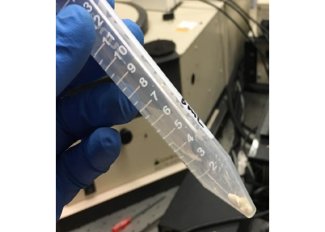In partnership with NETL, researchers at Idaho National Laboratory (INL), Rutgers, Arizona State University, OLI Systems and Lawrence Livermore National Laboratory are developing new sensing methods of detecting rare earth elements (REEs) contained within America’s fossil energy resources using luminescent detection.
REEs include the lanthanide elements along with scandium and yttrium. These elements are used in a wide variety of strategic and economically vital industries such as energy, defense, medical technology and consumer electronics. With most existing REE supplies controlled by foreign countries, the U.S. Department of Energy (DOE) and NETL have funded numerous research projects that will create a domestic REE supply chain using the nation’s historic energy resources.
INL sought to develop a new simple, sensitive and rapid approach for detecting REEs in any kind of carbon-based solid or liquid. This approach had to be applicable to diverse chemical and mineral matrices that will effectively detect REEs in aqueous solutions at less than one part per million (ppm) and distinguish it between multiple REEs co-occurring in the same sample.
Current detection methods have several limitations; analyses are expensive, time consuming and are usually conducted at a specialized materials testing laboratory. Yoshiko Fujita, Ph.D., INL’s principal investigator on this work, noted that multiple REEs can be rapidly detected simultaneously and distinguished from each other by luminescent detection of unique wavelengths.
Fujita and her team developed and applied their sensing technology based on the luminescence of lanthanides in fly ash resulting from combustion of Powder River Basin and Appalachian coals. The team determined that the approach also worked with pre-combustion resources from Pennsylvania, North Dakota, Virginia, Kentucky and Montana and expect that it will work with acid mine drainage.
The process relies on leaching of carbon-based materials with an acid and then reacting the leachate with a fluoride-containing reagent to produce stable mineral fluoride products that are excellent hosts for fluorescence. The resulting solids can be analyzed readily with a spectrometer and allows identification of individual elements.
Detection limits are highly dependent on the matrix, but even within the very complex matrix of carbon product leachates, some lanthanides present at single digit parts per billion levels in the leachates could be detected. Experiments to evaluate the kinetics of the leaching and precipitation steps were conducted with an eye toward determining whether this protocol could be accelerated to facilitate development of a field test used with low-cost light sources and detectors.
The extremely low solubility of the REE fluorides and their distinctive luminescence properties offer the potential for an elegant, rapid and accurate technique for detecting REE in a wide range of environmental sample types, potentially bringing to the market an entirely new methodology to screen for the presence and abundance of individual lanthanides in complex natural materials.
The researchers determined that fluoride precipitation allows luminescent REE detection in complex samples. This method has also been successful in detecting and distinguishing individual REEs. This could lead to an entirely new way in which REE sources are identified, analyzed and used as feedstock materials in bench or pilot-scale extraction, separation and recovery processing facilities. Furthermore, the generation of the fluoride precipitate to run this type of sensing is rapid , which lowers costs and barriers for widespread use.
Going forward, Fujita and the team are hoping to optimize the detection process to be faster and easier. They aim to pursue development of field testing kits using portable vials and syringe filters to detect REEs using a smartphone coupled with battery powered LED excitation light source.
“By developing easier and more reliable methods for detecting REEs for extraction from carbon-based samples, DOE-NETL is making the prospects of domestic REE production more attractive to the private industry,” said Charles Miller, project manager for NETL. “While more work is required to refine these detection methods, their applicability to samples across a wide geographic spectrum bodes well for developing a rapid, accurate and versatile detection system for REEs.”
NETL is a U.S. Department of Energy national laboratory that drives innovation and delivers technological solutions for an environmentally sustainable and prosperous energy future. By leveraging its world-class talent and research facilities, NETL is ensuring affordable, abundant and reliable energy that drives a robust economy and national security, while developing technologies to manage carbon across the full life cycle, enabling environmental sustainability for all Americans.




